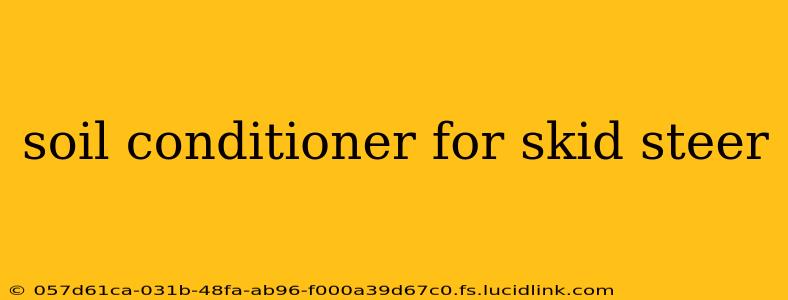Skid steers are workhorses on construction sites, farms, and landscaping projects, but their effectiveness hinges on the condition of the soil they operate on. Hard, compacted soil can severely limit maneuverability and productivity, leading to increased fuel consumption and equipment wear. That's where soil conditioners come in. This guide explores the crucial role of soil conditioners for skid steers, detailing their benefits, types, and application methods to optimize your machine's performance.
What are the Benefits of Using a Soil Conditioner with a Skid Steer?
Using a soil conditioner with your skid steer offers numerous advantages, directly impacting your operational efficiency and bottom line. Here's a breakdown of the key benefits:
-
Improved Traction: Soil conditioners break down compacted soil, creating a more stable and level surface for improved traction. This is especially crucial in wet or muddy conditions, preventing wheel spin and slippage.
-
Reduced Fuel Consumption: Better traction means less power is wasted overcoming resistance, leading to significant fuel savings over time.
-
Less Equipment Wear and Tear: Reduced stress on tires, tracks, and the machine's drivetrain translates to extended equipment lifespan and reduced maintenance costs.
-
Increased Productivity: Improved maneuverability and traction allow for faster and more efficient completion of tasks, boosting overall productivity.
-
Enhanced Soil Drainage: Soil conditioners can enhance drainage, preventing waterlogging and making the ground more suitable for operation, even after rainfall.
-
Easier Compaction: For applications requiring compaction, a pre-treated soil is easier to compact uniformly, resulting in a more stable and durable surface.
What Types of Soil Conditioners are Suitable for Skid Steer Applications?
Several types of soil conditioners can be effectively used with a skid steer, each offering unique properties:
-
Lime: Raises the pH level of acidic soils, improving nutrient availability and overall soil structure. It's particularly effective on clay soils.
-
Gypsum: Improves soil structure, especially in heavy clay soils, enhancing drainage and aeration.
-
Compost: A natural soil amendment rich in organic matter, improving soil structure, water retention, and nutrient content. It's excellent for improving soil health long-term.
-
Sand: Adds porosity to heavy clay soils, improving drainage and reducing compaction.
-
Shredded wood/bark: Improves soil drainage, aeration and water retention, with a positive effect on organic matter.
How to Apply Soil Conditioners with a Skid Steer?
The application method depends on the type of soil conditioner and the scale of the project. However, skid steers, equipped with appropriate attachments, offer versatile application options:
-
Box Blade: Ideal for incorporating smaller amounts of granular conditioners like lime or gypsum into the topsoil.
-
Bucket: Suitable for larger quantities of loose materials such as compost or sand, allowing for efficient spreading and mixing.
-
Rotary Tiller/Tillers: The best option for thoroughly mixing conditioners into the soil at varying depths, achieving optimal results.
-
Spreaders: For larger projects, specialized spreaders can be attached to a skid steer for even application of granular materials.
What are the Common Problems Encountered When Using Soil Conditioners?
-
Uneven Application: Inconsistent application can lead to inconsistent results, requiring careful operation and potentially multiple passes.
-
Over-Application: Using excessive amounts of conditioners can be detrimental, negatively impacting soil properties. Careful consideration of soil type and required amounts is crucial.
-
Incorrect Conditioner Choice: Choosing the wrong type of conditioner for the specific soil type can be ineffective or even harmful.
-
Lack of Mixing: Insufficient mixing of the conditioner into the soil reduces the effectiveness of treatment.
What are the Environmental Considerations of Soil Conditioning?
While generally beneficial, environmental considerations are important. Certain conditioners, especially those containing chemicals, may require careful handling and disposal to avoid environmental contamination. Using natural and organic options, like compost, minimizes environmental impact.
How Do I Choose the Right Soil Conditioner for My Project?
Selecting the appropriate soil conditioner requires considering several factors:
-
Soil Type: Different soil types (clay, sandy, loamy) respond differently to different conditioners. Soil testing is often recommended to determine the soil's composition and pH level.
-
Project Goals: Are you aiming to improve drainage, increase nutrient content, or improve compaction?
-
Budget: Cost varies considerably between soil conditioners.
-
Environmental Concerns: Consider the environmental impact of the chosen conditioner.
By understanding the benefits, types, and application methods of soil conditioners, you can significantly improve the performance and efficiency of your skid steer while minimizing wear and tear and enhancing soil health. Remember to always prioritize safety and adhere to manufacturer guidelines for equipment operation and maintenance.
